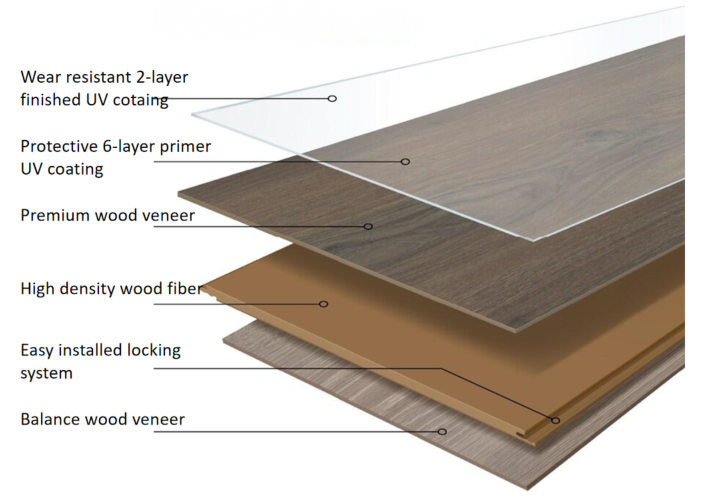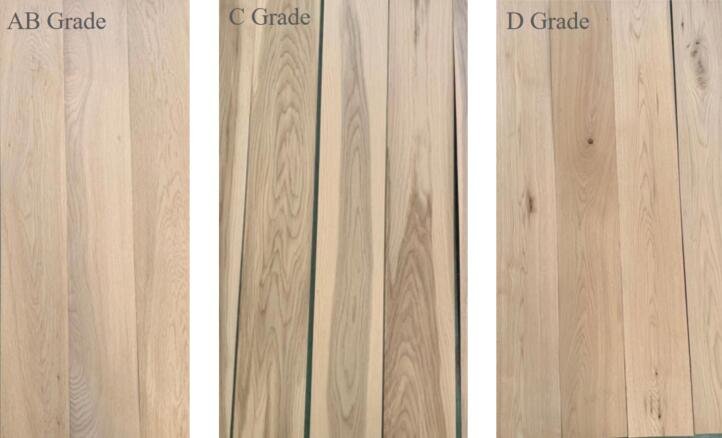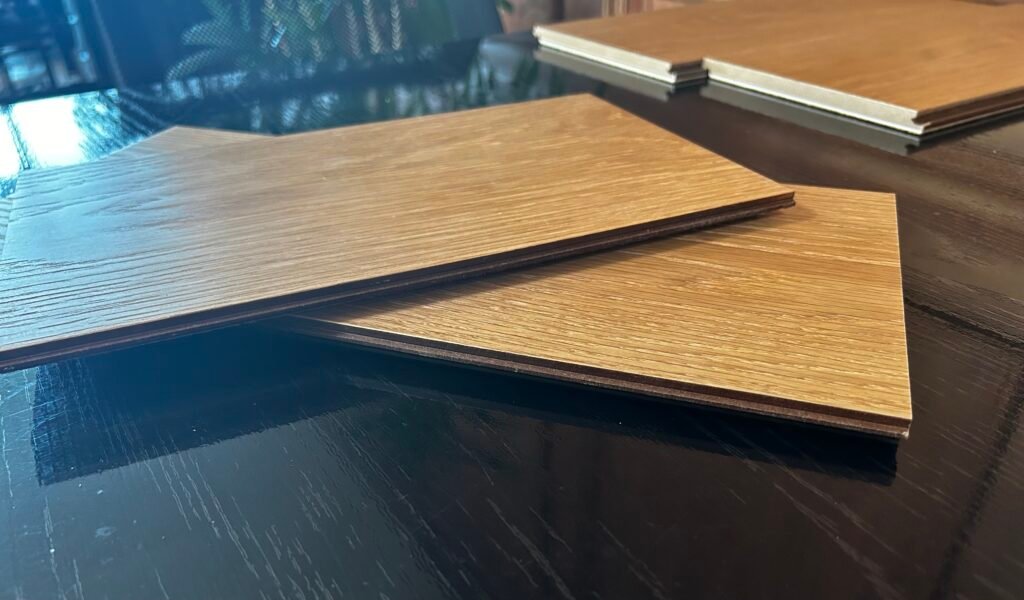The definition of Veneer Wood Flooring
Veneer Wood flooring (also called veneer DHF flooring) is a type of hardwood flooring with a premium and elegant layer of hardwood veneer on top of HDF core. HDF is made by compressing wood fibers under high pressure and heat, leading to a dense and durable board that resists swelling, warping, and splitting.
Nowadays, veneer wood flooring is an excellent choice for customers who prefer the look and feel of hardwood flooring without the high cost and environmental impact.

What is Wood Veneer layer:
The veneer layer is usually made of high-quality hardwood, such as oak or maple, and is typically between 0.5mm to 3mm thick, usually 1.2mm & 2.0mm are highly recommended considering the practicability.
How many kinds of top veneers can we meet frequently?
As for the types of veneer that are popular, it really depends on personal preference and style. Let’s see some of the most popular veneers below:
Oak – Oak is a classic and timeless choice that is durable and can come in a range of colors.
Maple – Maple has a more uniform and lighter appearance, which can work well in modern or minimalist settings.
Walnut – Walnut has a rich, warm tone and distinctive grain pattern that can add character and sophistication to a space.
Cherry – Cherry has a reddish hue and a smooth, consistent grain pattern that can create a luxurious and elegant feel.
Birch – Birch has a light, creamy color and a subtle grain pattern that can lend a fresh and modern look to a space.
The choice of veneer will depend on your personal style and the overall aesthetic of the room you are installing flooring.

What is Veneer Class?
What is Veneer Class?
The Level A, B, C, and D are used to grade the quality of hardwood veneer layers on flooring and other products. These grades are typically based on the appearance and quality of the veneer layer, with higher grades representing a better appearance and fewer defects.
Here’s a breakdown of the differences among the ABCD-level veneer layers:
A Grade Veneer Layer: This is the highest quality veneer layer, with no visible defects or knots. The grain is consistent and there are no discolorations, splits, or cracks. A grade veneer is typically used for high-end flooring or furniture.
B Grade Veneer Layer: is also a high-quality veneer layer, but it may have some visible defects, such as small knots or irregular grain patterns. B-grade veneer is typically used for high-quality flooring or furniture.

C Grade Veneer Layer: may have more visible defects, such as larger knots, mineral streaks, or discolorations. It may also have slight imperfections in the grain pattern. C-grade veneer is typically used for mid-range flooring or furniture.
D Grade Veneer Layer: has the most visible defects, such as large knots, cracks, or splits. The grain pattern may be irregular or have blemishes. D-grade veneer is typically used for lower-end flooring or furniture, or for purposes where appearance is not as important.
It’s important to note that grading standards may vary among manufacturers and regions, so it’s always a good idea to ask for specific grading information from your veneer-engineered floor supplier before making a purchase.
Ultimately, HDF Veneer flooring is affordability compared to solid hardwood flooring. It is also more stable and less prone to expansion and contraction due to changes in temperature and humidity. Additionally, because the veneer layer is relatively thin, the same amount of hardwood can be used to cover a larger area, making it a more sustainable and environmentally friendly choice.
Written by Kevin Wong
Kevin.wong@yhfloors.com

